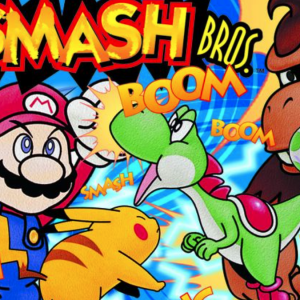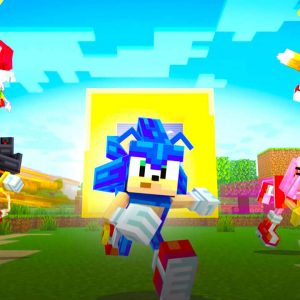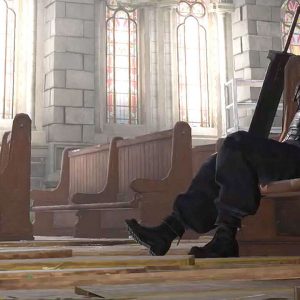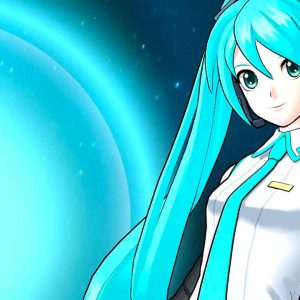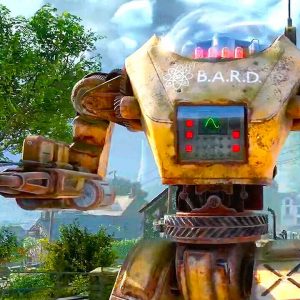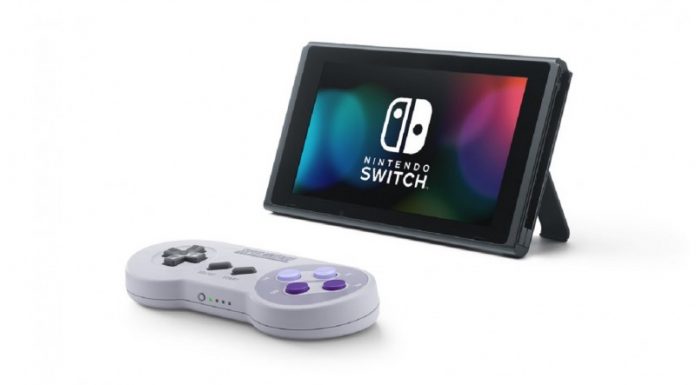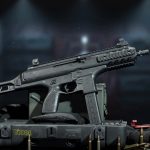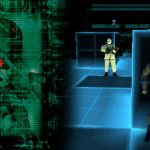Respawn’s battle royale is fun and polished enough to go toe-to-toe with the titans of the genre.
Apex Legends is something of a zeitgeist stew, checking all of the boxes of recent trends all the way down to its grandiose but nondescript title. It’s one part by-the-numbers battle royale, complete with the descent from the sky, emphasis on scavenging for loot, and shrinking playable area. It’s another part hero shooter, featuring eight characters called Legends with unique ability sets built for steadfast teamwork. It comes decked out with all the modern free-to-play, games-as-service fixings, including weapon skins, emotes, seasons stretching throughout the rest of the year and (hopefully) years to come, and even the much-maligned loot boxes. None of those borrowed ideas scream originality on their own, but here they come together as something totally new thanks to a roster of personable Legends, a single lavishly designed map, and a smart approach to its mandatory three-person squads. Add great gunplay, a groundbreaking communication system, and a degree of polish that’s all but unheard of in this genre, and Apex Legends has burst onto the scene as one of the most refined and entertaining battle royale games I’ve played.
Set in the Titanfall universe (but conspicuously lacking the signature Titans, falling or otherwise,) a match of Apex Legends is relatively small scale: 20 teams of three compete in a last-team-standing competition on a gradually shrinking, sci-fi-infused map. At first, I was worried about the mandatory squad-based setup, given my less-than-great experiences playing with randoms in other battle royale games. So far, however, I’ve been pleasantly surprised, in large part because of excellent non-verbal communication.
While it certainly helps to talk to your teammates with a mic, Apex Legends has an intuitive contextual ping system that’s better than every other battle royales. With the tap of a button you can call out points of interest, whether that be supplies, enemy locations, or just a spot you think the team should go towards, and your character will verbally acknowledge the pings by intelligently translating what you wanted to say to your team. It’ll even offer up other bits of dialogue automatically, such as when shots are fired. I’m genuinely amazed at how advanced this incredibly simple-to-use system feels. I’ve marked unassuming enemies closing in on our location and watched as my teammates converged on their location from different angles, flanking them without so much as a single word spoken. Likewise, while your search for loot may be turning up nothing but measly pistols and loads of attachments you can’t use, one of your teammates might find and mark a useful SMG for you to grab.
“
The vast majority of players are effectively using the ping system to coordinate.
In my 20-or-so hours of playing on PS4 over the past week, I’ve found that the vast majority of players are effectively using the ping system to coordinate with their teammates rather than going off on their own. It’s a revelation for those of us who thus far haven’t particularly cared for playing with randoms online, regardless of whether they have a mic or not.
It’s great that the ping system exists because cohesive teamwork really is the only way to make it to the end of a match. That’s in part due to the fact that Apex Legends is unique among battle royale games thus far in that it’s possible to revive a teammate even after they’ve bled out and completely died. (It turns out they’re only mostly dead.) A teammate can grab your banner within 90 seconds of your death and make the trek to the nearest beacon, which brings you back from the dead via a spectacular dropship landing that is sure to draw the attention of every squad in the area. The multi-step process – during all of which you’re leaving yourself vulnerable – means you have to deal with nearby threats quickly if you want to resurrect someone, because it’s effectively impossible to do while being shot at. That only further places the focus on solid teamwork.
A handful of my deaths have come from making ill-advised attempts at securing a banner before the timer runs out. But the risk that comes with the reward of keeping your squad full, in my experience, has always been worth it. Near the end of the match at least a few teams are typically fully intact and strapped with all of the best loot grabbed from fallen players; in these confined, high-stakes moments, being short even one teammate is hard to overcome. Each of my several victories have been won with all three of us still alive. Surprisingly, this respawn system is implemented in such a way that it doesn’t really drag out the match length, so even matches where I made it to the end have taken around 20 to 25 minutes.
The varied Legends you choose from add new wrinkles to the battle royale format and further place the focus on playing as a team. The eight options (two of whom are initially locked behind a grind-or-pay wall) each have their own neat tactical, passive, and chargeable ultimate abilities that can come in handy at times. That said, because firepower is determined by the guns you find rather than the class you pick, they don’t feel as absolutely necessary as the class interplay of something like Overwatch, where a support character will get smoked by a DPS; in Apex Legends, the abilities feel more like perks than full-blown, restrictive identities, so you can play as anybody you like and your team will likely be viable. This has encouraged me to try different characters without worrying much about team balance. Mostly, I’m finding the Legends to be a fun addition because of their voice acting, all of which is upbeat.
I’ve latched onto Bangalore, a DPS Legend, and Gibraltar, a defensive Legend, largely because of their ultimate abilities, which happen to be quite similar. Bangalore can call in a sweeping artillery strike and Gibraltar has a more confined mortar strike, both of which I’ve used to successfully take down entire teams who carelessly bunched up. Other Legends have cool and useful situational abilities: Wraith can create a void to teleport to safety, the Pathfinder is a robot with a grappling hook for quick movement, and Bloodhound has a tactical ability that can show enemy locations and footprints. Lifeline is a traditional healer with a passive ability that lets you revive teammates quicker behind the safety of a shield, and her tactical move deploys a tiny drone that heals nearby players. With her ultimate fully charged, you can call in a supply drop filled with solid defensive gear.
“
Legend abilities can save your squad or get you out of a tricky situation.
Occasionally, the Legend abilities can save your squad or get you out of a tricky situation, but like other battle royale games, Apex Legends is all about the loot. As has become standard, it’s scattered everywhere with supply ships periodically dropping high-tier gear you can risk going after if you think no one’s watching. Supply bins and buildings are also littered with helmets, body armor, ammo, grenades, health kits, and shield boosts. One of the loot features I like most is that it doesn’t let you pick up worse gear than what you already have, saving you precious backpack space (ammo, on the other hand, does take up inventory space).
Like both Titanfall games, Apex Legends’ gunplay is impactful and precise. The guns themselves are fairly standard fare: SMGs, shotguns, LMGs, assault rifles, pistols, and sniper rifles, but each gun has a satisfying kick and sound when it fires, and they all have a distinct weightiness which makes them feel unique to use. Numerical damage points pop off of enemies when you hit them, and these are cleverly color-coded to inform you the type of armor – if any – the enemy currently has on. Guns can be modified with scopes, extended magazines, and barrel stabilizers, but the most noticeable modifications are hop-ups like the Precision Choke for the Peacekeeper and Triple Take, which decreases pellet spread while aiming down sight and adds a fun particle animation along the way. From a gameplay standpoint, the Peacekeeper, in particular, feels like an entirely different weapon with the mod attached and I’d love to see more impactful hop-ups like this added in the future.
The absence of the wondrous wall-running and Titans makes Apex Legends a different experience for sure, but it feels amazing to run into a slide down a hill, look down your sight, and pick off an opposing player in the distance. The ability to climb over walls and ledges gives you a touch of Titanfall’s vertical mobility, at least.
“
Wow: King’s Canyon is already easily my favorite battle royale map.
Apex Legends currently has just one map, called Kings Canyon, but wow: it’s already easily my favorite battle royale map. The layout is absolutely bonkers, in the best way: it has rushing waterfalls, elaborate multi-floor military complexes, commercial areas, grassy jungles, sandy wastelands, and settlements stretching across ruined embankments. I saw giant Tauntaun-like creatures swaying in the distance, and walked through a rib cage of a massive creature in an area that reminded me of Halo 2’s Burial Mounds map. None of it really makes sense as a real place, of course, but it’s a lot of fun to move and fight across.
One of the smartest things Apex Legends does with its map solves one of my major gripes with most battle royale games. Since the playable area shrinks every few minutes, some of the coolest features of the maps are only in play for short spurts. Or worse: some maps have a ton of wasted, boring space. But here, I haven’t run into anything like that in the dozens of matches I’ve played so far. All areas of the map are rich with detail and interesting to explore, and full of things like horizontal and vertical ziplines to get around quickly. (Some are attached to balloons and effectively relaunch you into the sky to redeploy to a different area of the map.) Even when you don’t see an opposing team for the first five minutes or so – and this has happened to me several times – the map provides thrills of its own. One minute you’re running through an underground tunnel and the next minute you’re scaling a cliff that reveals a massive building filled with high-tier loot. That might diminish over time as we learn the ins and outs of this new, barely explored map, but I’m enjoying the discovery more than usual.
Despite the smaller player count per match, I’m finding more often than not that about half the teams are eliminated during round one – before the ring shrinks for the first time. Some of these early skirmishes can be attributed to dropping in popular areas such as the Hot Zone (a special high-tier loot area), but other times it seems to be the luck of the draw. You never really know what you’re going to find in a building. If a nearby team is fully stocked and your team is still looking for something better than a pistol, well, it’s open season on your squad. Every battle royale game so far has unfortunate early moments where you feel like you simply got unlucky. I consider that to be part of the genre’s charm, and it’s still present here. Once you make it to round two and beyond, however, happenstance is replaced by a game of skill. The late game, when the ring is as small as one named area and only a few teams remain, is simply riveting. It’s where your team communication skills are most important and where Legend abilities can sway the tides of victory in your favor.
Besides the two character unlocks, Apex Legends follows the microtransaction models of games like Fortnite and Overwatch, which depend on a level playing field for every combatant and reserves out-of-match purchases for Apex packs (loot boxes) containing cosmetics, such as skins and emotes. While you’re not entirely dependent on the exact item you want popping out of the box, obtaining a specific skin is somewhat of a convoluted process. First, you have to earn or buy a loot box and hope that crafting metal is one of the three items. Once you have enough crafting metal, you can use it to buy the specific skin of your choice. But opening loot boxes is unavoidable, though you only earn one pack each time you level up. Thankfully, if you do spend money you’ll never get a duplicate item.
The process for unlocking the two characters, however, is somewhat laborious without spending money. It took me around 15 hours to earn enough to unlock one of the two characters. Buying both Legends with real money will set you back $20 (with five bucks’ worth of currency left over for cosmetics). That said, from my experience, the two locked characters aren’t better than the six you have from the start, so there’s no pay-to-win scheme going on here at launch. They don’t give you a competitive advantage – just a different way to play – but their availability gives you something to work towards or pay for upfront, if you so choose. That said, Respawn plans to add new Legends, cosmetics, and loot every few months, which could result in a setup like League of Legends and Smite. That’s not as generous as some fully free-to-play games like Dota 2, but it’s definitely a proven model.
The Verdict
Apex Legends makes squad-based battle royale work better than thought possible, even when playing with a randomly matched team. Its intuitive communication system makes strategic teamplay achievable without a word, and the eight unique legends each have cool abilities that are rewarding without feeling like restrictive roles. It all takes place in Kings Canyon, which is a fascinating sci-fi map that leads to tense encounters filled with all of the pristine gunplay and polish from the Titanfall series, and its free-to-play setup doesn’t pressure you to pay to keep up. Apex Legends has the goods to be a true challenger to Fortnite’s dominance.





